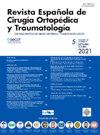[Translated article] Intrapelvic suprapectineal acetabular plates interfere with the quality of reduction evaluations on postoperative X-rays: A retrospective case series
Q3 Medicine
Revista Espanola de Cirugia Ortopedica y Traumatologia
Pub Date : 2025-05-01
DOI:10.1016/j.recot.2025.02.011
引用次数: 0
Abstract
Introduction
Intrapelvic suprapectineal plates play an important role in acetabular fracture fixation. However, the shape of these implants may interfere with the quality of reduction evaluations using plain X-rays. We sought to evaluate this artefact and its relationship with CT findings.
Materials and methods
In a retrospective, single-centre series of 22 acetabular fractures, postoperative AP, alar and obturator X-ray views and CT images were evaluated by three independent observers. Cohen's kappa was used to examine interrater reliability.
Results
Suprapectineal plates interfered with the evaluation of the weight-bearing surface in 75.3%, and with all three oblique views in 43.9% of cases. The central segment was most consistently interfered with, corresponding to the area where the greatest malreduction was in 46.9% coronal and 42.4% of sagittal CT views.
Conclusions
Since the quality of reduction has prognostic value and is a necessary guide for the surgical team, that CT may be considered for the postoperative examination of the most challenging acetabular fracture cases.
盆腔内阴蒂上髋臼钢板影响术后x线复位评估的质量。回顾性病例系列。
导言:骨盆内耻骨上钢板在髋臼骨折固定中起着重要的作用。然而,这些植入物的形状可能会影响使用x光平片进行复位评估的质量。我们试图评估这一伪影及其与CT表现的关系。材料和方法:回顾性研究了22例髋臼骨折的单中心序列,术后AP、鼻翼和闭孔x线片和CT图像由三名独立观察者进行评估。Cohen’s kappa用于检验互译者的信度。结果:在75.3%的病例中,阴蒂上板干扰了对负重面的评估,在43.9%的病例中,三种斜位视图都干扰了。中央节段最一致被干扰,对应于46.9%的冠状位和42.4%的矢状位CT视图中最大复位的区域。结论:由于复位质量具有预后价值,是手术团队的必要指导,因此对于最具挑战性的髋臼骨折病例,可考虑进行CT术后检查。
本文章由计算机程序翻译,如有差异,请以英文原文为准。
求助全文
约1分钟内获得全文
求助全文
来源期刊

Revista Espanola de Cirugia Ortopedica y Traumatologia
Medicine-Surgery
CiteScore
1.10
自引率
0.00%
发文量
156
审稿时长
51 weeks
期刊介绍:
Es una magnífica revista para acceder a los mejores artículos de investigación en la especialidad y los casos clínicos de mayor interés. Además, es la Publicación Oficial de la Sociedad, y está incluida en prestigiosos índices de referencia en medicina.
 求助内容:
求助内容: 应助结果提醒方式:
应助结果提醒方式:


